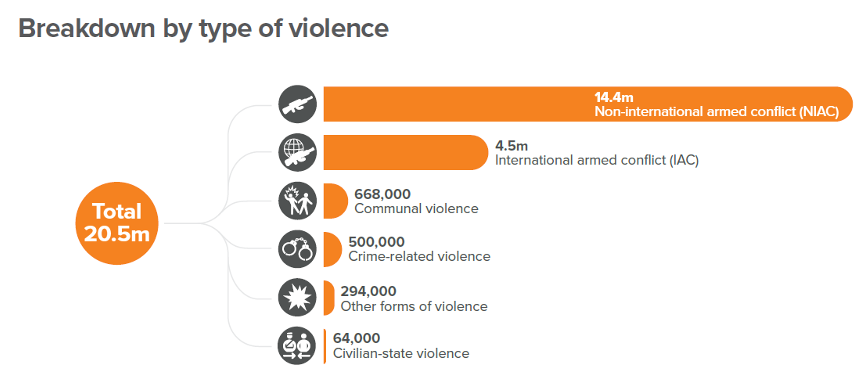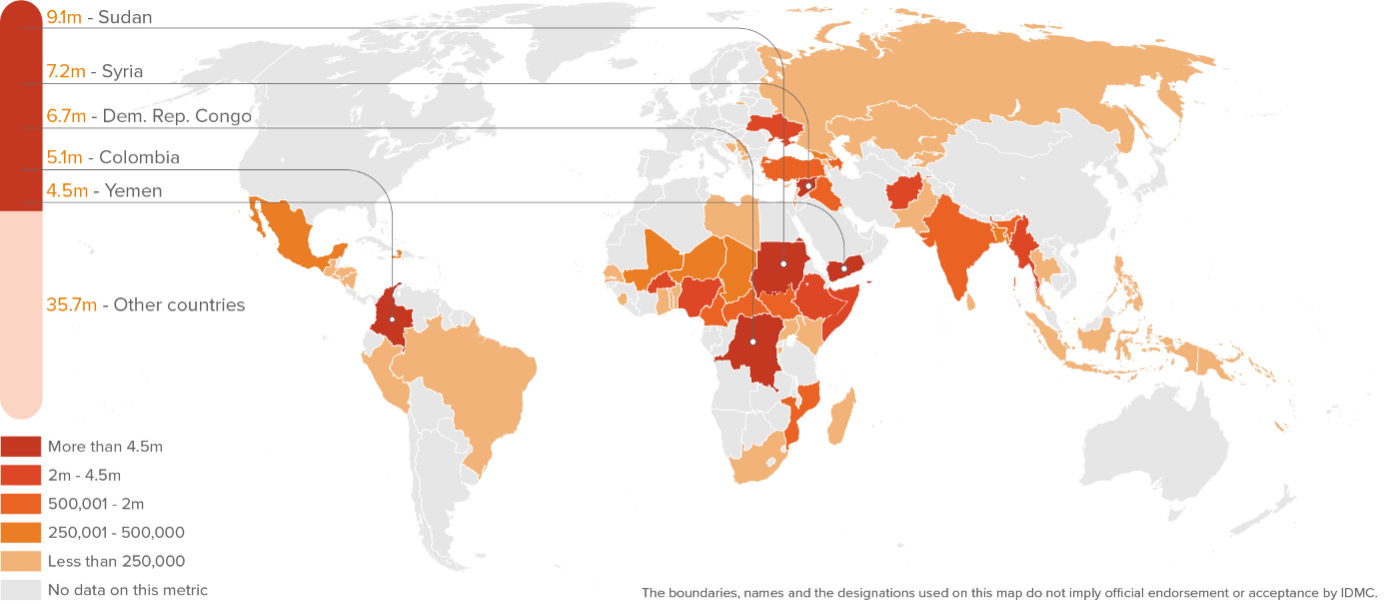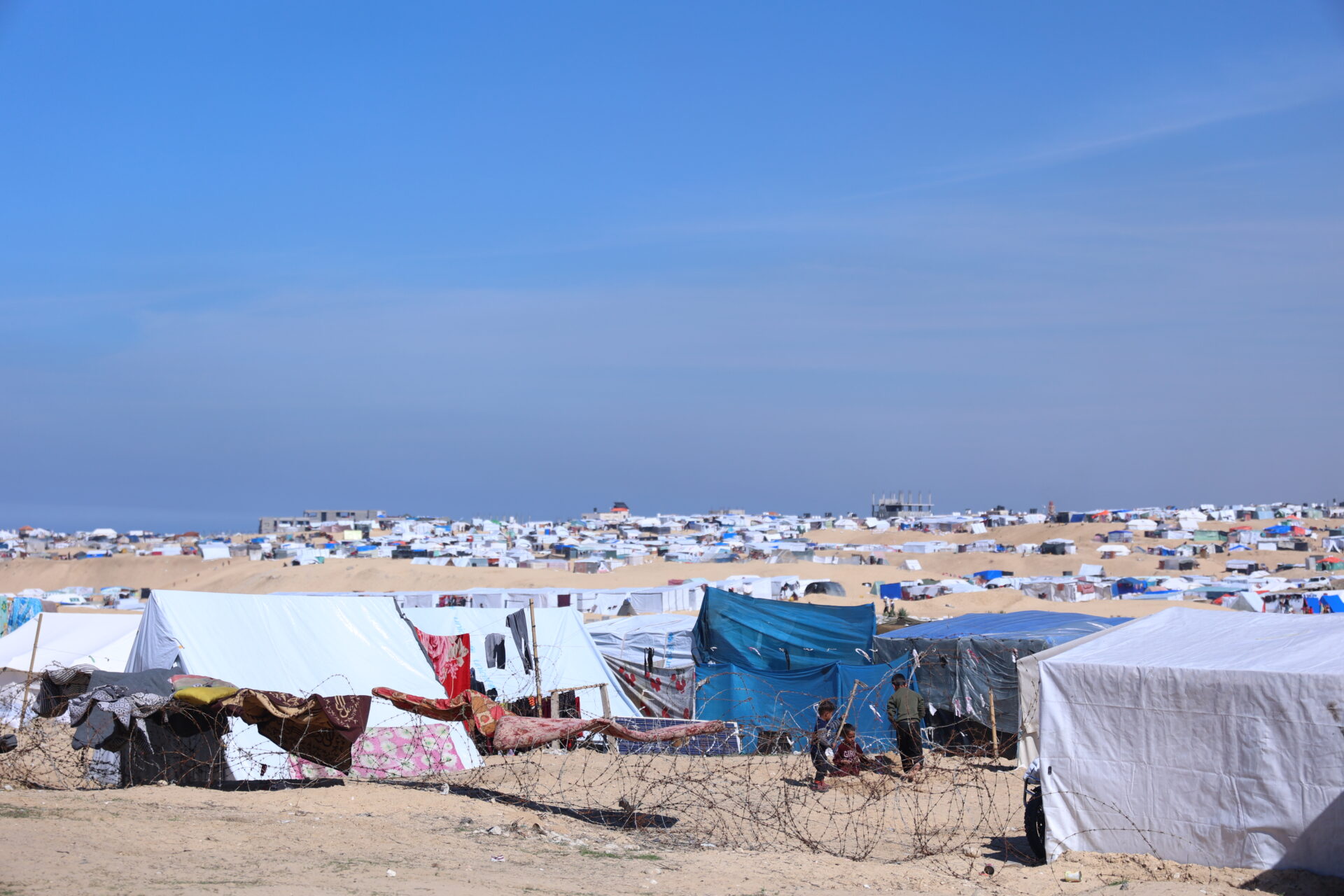Year after year, the Internal Displacement Monitoring Centre (IDMC) reports an ever-increasing number of Internally Displaced People (IDPs). This year was no different, as its Global Report on Internal Displacement highlighted, in 2023, 68.3 million people were displaced within their own countries as a result of conflicts and violence around the world, nearly 6 million more than 2022. This unprecedented number was due to protracted crises, such as the ones that have been weighing on Syria, the Democratic Republic of the Congo (DRC), Colombia and Yemen for years or even decades, further increased by new or renewed conflicts. Amongst these, the alarming levels of internal displacement recorded in Palestine, Ukraine or Sudan in 2023 – and more countries, such as Lebanon, in 2024 – are on everyone’s minds. Other crises may be less visible internationally, but available data shows that people were forced out of their homes in a total of 45 countries and territories in 2023.
Behind these numbers are women, men and children facing a multitude of risks in different contexts, with diverse needs, wishes and means to address them. In this article, we look beyond the numbers to understand what prompted these displacements, who are the people most impacted by conflict and violence related displacements around the world and how they experience their life away from home.
The ‘Why’: What causes conflict and violence related displacement?
Non-international armed conflicts, such as the ones unfolding in Sudan, DRC, Ethiopia, Burkina Faso or Somalia, prompted around 70 per cent of all internal displacements linked with conflicts and violence in 2023. International armed conflicts, such as the ones occurring in Ukraine or Palestine, led to about 22 per cent of all such movements. Communal violence, crime-related violence, civilian-state violence and other forms of violence also forced people to flee. Displacements linked with crime-related violence in particular, saw a 45 per cent increase compared to the previous year, mostly linked with crises in Haiti and Nigeria. But unveiling the root causes of these displacements requires much more information than this breakdown by type of violence. Displacement situations of such scale and duration build on multiple layers of fragility and years or decades of unresolved issues.

Source: IDMC, Global Report on Internal Displacement 2024
The war that started in October 2023 prompted at least 3.4 million displacements in the Gaza Strip in the last quarter of 2023 alone – the highest number of internal displacements recorded for Palestine since data became available in 2008. But this explosion of displacement had been brewing for decades: violence had forced hundreds of Palestinians to flee each year for the past 15 years, with notable escalations in 2009, 2014 and 2021, which forced hundreds of thousands from their homes before the latest developments. In Israel, 203,000 internal displacements were recorded in 2023, and their average number between 2009 and 2022 was almost 1,900. Even before October, both countries had experienced an increase in displacement since January 2023: more than a three-fold increase in the total for 2022 in Palestine, and twice as many for Israel, resulting from violence between Palestinian non-state armed groups and Israel Defence Forces in the Gaza strip and from Israeli settler violence, home demolitions and an overall coercive environment in the West Bank.
Historical analyses of displacement trends and other contributing factors are key to identify ways to prevent escalation and invest in lasting solutions. The first IDMC Middle East and North Africa report on internal displacement, published in 2021, delved into the drivers and triggers of displacement in the region, including an already alarming overview on Palestine, as well as Yemen, Libya and Syria. An upcoming IDMC report on 15 years of internal displacement in Africa, scheduled for publication in December 2024, will also look back at some of the underlying drivers of conflict and violence related displacement in the region which is home to nearly half of all IDPs in the world.
Inequalities of access to natural resources and economic opportunities, food insecurity, tensions between ethnolinguistic communities, poverty and corruption are amongst the most common ingredients for conflict related displacement crises. In 2023, 65 per cent of all internal displacements by conflict and violence took place in countries classified as low income by the World Bank, compared to only one per cent in high income countries (28 per cent in lower middle income and 6 per cent in upper middle income countries).
Disasters such as droughts repeatedly affecting already conflict-ridden Somalia or Ethiopia, floods like the ones that devastated Derna in Libya, or earthquakes like the ones that hit Türkiye and Syria often increase the difficulties of already overstrained populations. All but three of the 45 countries and territories for which IDMC recorded conflict displacement in 2023 year also recorded disaster displacement.
Who is internally displaced by conflicts and violence?
In 2023, conflicts and violence forced people away from their homes in every region of the world in low- and high-income countries. But sub-Saharan Africa was once again the region most affected by the phenomenon, with 46 per cent of the world’s conflict IDPs. It was followed by the Middle East and North Africa, where the conflict in Palestine contributed to a dramatic increase in the number of IDPs. Europe and Central Asia were not spared as the conflict between Russia and Ukraine displaced millions of people. In the Americas, violence in Colombia and Haiti triggered the largest number of internal displacements since records began in 2009. South Asia also accounted for 5.3 million IDPs as a result of conflict and violence, nearly 4.2 million of them in Afghanistan. In East Asia and the Pacific, new and protracted crises in Myanmar, the Philippines, Papua New Guinea and others added nearly three million IDPs to the global total.

Source: IDMC, Global Report on Internal Displacement 2024
Beyond the countries they live in, we know little of the people behind these figures. Information on IDPs’ sex, age, disability status and other characteristics is rarely collected, as sparse resources, emergency situations and access constraints hinder the collection of comprehensive data. Applying national level data to estimate the demographic distribution of internally displaced populations can help get a sense of the number of men and women of different age groups living in internal displacement, but this is not enough to plan adequate support. In situations where data is collected on the demographic characteristics of IDPs, significant differences can be found between their profile and that of their national population. In Burkina Faso, for instance, the humanitarian needs overview conducted by the United Nations Office for the Coordination of Humanitarian Affairs in 2023 found that 60 percent of the IDPs who were deemed in need of humanitarian support were children, though children make up only fifty percent of the general population. Another assessment of people displaced by violence in Quibdó and Caucasia, Colombia, highlighted a much higher dependency ratio amongst IDPs than amongst their non-displaced neighbours or the national population.
People who are poorer, marginalized or somehow less able to withstand the shock of a conflict or the threat of violence are at higher risk of being displaced when such shocks occur. Depending on the context, this can mean that women, children, older individuals or people with disabilities tend to be found in higher proportions in internally displaced populations than in the non-displaced populations. This goes beyond demographics to also encompass social characteristics, such as education and income levels. A survey conducted by IDMC in Cameroon in 2023 showed that only 20 per cent of the respondents who had been forced to find refuge in the Bogo and Louggol camps as a result of violence had received some level of education, compared to 90 per cent of the non-displaced respondents in the surrounding areas.
This general trend does not always hold true, however. In certain contexts, people with disabilities, for instance, are less represented in the internally displaced population than in the non-displaced population because they were unable to flee their home without assistance and stayed behind, even in the face of conflict or violence.
Such gaps in our understanding of who internally displaced people are inevitably limit our ability to provide them with tailored support. Yet, as the following section will show, who they are is a central piece of information to guide how we can help them overcome their displacement.
How do IDPs experience their lives away from home?
Displacement can have far-reaching and long-lasting consequences on IDPs’ livelihoods, housing conditions, physical and mental health, education, security and social life. In Gaza, repeated displacements, lack of clean water, sanitation, medical supplies and personnel and overcrowding in makeshift shelters has led to the spread of communicable diseases, including the resurgence of poliovirus for the first time in 25 years. These diseases, as well as the dramatic impacts on mental health, may have repercussions on IDPs for years to come. So will the educational gap children currently displaced by the conflict are experiencing and will continue to experience, as nearly 90 per cent of schools in Gaza have been damaged or destroyed. Rebuilding the houses, infrastructure and livelihoods shattered by the conflict will likely take decades – further delaying the prospect of durable solutions.
Displacement can also lead to more displacement. The vulnerabilities IDPs face place them at greater risk of onward displacements. In Syria, for instance, most of the people displaced by the February 2023 earthquakes had already been displaced by conflict in Aleppo, Idlib and Lattakia governorates and were living in informal settlements that could not withstand the earthquakes’ shocks. The poor housing conditions in which IDPs are often forced to live place them at greater risk of disaster-related displacement and evictions, as reported recently in Afghanistan, Libya, Somalia or Yemen.
Displacement-related vulnerabilities can endure as IDPs struggle to secure decent livelihoods in new communities where they may face stigma, might need to adapt to a different labour market and learn new skills, or may simply lack the professional connections and social support networks that would otherwise help them find work. An analysis conducted in 2024 by IDMC on datasets from REACH’s Multi-Sector Needs Assessments in 11 countries showed that lack of a stable income source was more frequently reported by internally displaced households than non-displaced households in all countries but one. Other surveys of people internally displaced by violence in Cameroon and Mali in 2023 showed that the median monthly income of internally displaced households dropped by 70 to 80 per cent after displacement.
The Inter-Agency Standing Committee’s (IASC) Framework on Durable Solutions for IDPs explains that a solution to displacement is achieved only when “IDPs no longer have any specific assistance and protection needs that are linked to their displacement and can enjoy their human rights without discrimination on account of their displacement”. Information on whether these conditions are met, however, is rarely available.
Where it exists, data on “solutions” to internal displacement, either through return to place of origin or local integration in a new community, often only reflects “where” IDPs are – not the conditions in which they live. The International Organisation for Migration’s PROGRESS report provides an analysis of IDP return data for 13 countries, including some of the nations most heavily affected by conflict and violence related displacement. Other sources, such as the Multi-Sectoral Needs Assessments (MSNAs) conducted by REACH, go beyond movement-related information to measure the specific vulnerabilities of IDPs, but data gaps remain for many conflict crises.
Conclusion
The complex drivers and impacts of internal displacement in contexts of conflicts and violence, and the overlapping challenges affected countries and communities face, mean that the challenges faced by affected countries and communities are unlikely to be resolved on their own. Although internal displacement is an issue of national sovereignty, under the responsibility of the affected government, bringing the world’s many unfolding crises to an end will require external support. It requires the contributions of the international community, including humanitarian, development and peacebuilding actors. The call for all to join in efforts to address internal displacement was formalized in the United Nations Secretary General’s Action Agenda on Internal Displacement.
For multilateral and cross-cutting support to deliver results, however, comprehensive information on what drives displacement, who IDPs are and what they need to overcome their displacement is essential. While data on internal displacement has improved much over the past decades, many knowledge gaps remain. The Internal Displacement Monitoring Centre, amongst others, is committed to working to bridge these gaps and provide policy makers, donors and practitioners with the information they need to design more impactful investments and interventions to prevent and resolve conflict-related internal displacement.
Christelle Cazabat is the Head of Programmes at IDMC, where she oversees the organisation’s programme work, including global monitoring and reporting on internal displacement, research on its drivers, patterns, impacts and solutions, and displacement risk analyses. She has worked on international development since 2007 – for the French Embassies in the Dominican Republic and in Cameroon, the United Nations Population Fund’s country office in Cameroon, the World Health Organization’s Eastern Mediterranean regional office in Egypt and headquarters in Geneva, and the Human Development Report Office of the United Nations Development Programme in New York.
KEYWORDS: Displacement, IDPs, Conflict, Solutions
Bibliography
Inter-Agency Standing Committee, IASC Framework on Durable Solutions for Internally Displaced Persons, 2010.
Internal Displacement Monitoring Centre, 2024 Global Report on Internal Displacement, 2024.
Internal Displacement Monitoring Centre, 2024 Mid-Year Update on Internal Displacement, 2024.
Internal Displacement Monitoring Centre, Global Internal Displacement Database, 2024.
Internal Displacement Monitoring Centre, 25 years of progress on internal displacement 1998-2023, 2023.
United Nations, Guiding Principles on Internal Displacement, 1998.
United Nations, Secretary-General’s Action Agenda on Internal Displacement, 2022.

